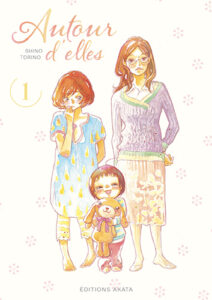 Hello and welcome to Guest Review Wednesday on Okazu! We have a brand new reviewer today and I’m very excited, because she’s reviewing a series that I loved in Japanese, but which has not made it to English. I reviewed the whole series in Japanese here on Okazu and found it complex and compelling. I hope our French-speakers in the audience will pick this series up. The mic is yours, Fraise!
Hello and welcome to Guest Review Wednesday on Okazu! We have a brand new reviewer today and I’m very excited, because she’s reviewing a series that I loved in Japanese, but which has not made it to English. I reviewed the whole series in Japanese here on Okazu and found it complex and compelling. I hope our French-speakers in the audience will pick this series up. The mic is yours, Fraise!
In a few words: I am a historian (M.A.) specialized in popular and scientific representations in media, mainly newspapers. I write mostly non-fiction under my legal name but will occasionally dabble in fiction under my pen name. You can fine me on Twitter @aurantium.
“Loneliness is the human condition. Cultivate it. The way it tunnels into you allows your soul room to grow. Never expect to outgrow loneliness. Never hope to find people who will understand you, someone to fill that space. An intelligent, sensitive person is the exception, the very great exception. If you expect to find people who will understand you, you will grow murderous with disappointment.”
– Janet Finch, White Oleander
« Rien ne vaut son chez-soi. »
“There’s no place like one’s home.”
During their college years, beautiful, poised Maya and “wild child” Michiru were a couple…depending on Michiru’s whims. Small and elusive, Michiru kept throwing herself in anyone’s arms, men and women alike, as if to try and get rid of something by doing so. Nonetheless, she often ended up finding Maya to the point of “squatting” in the same studio as her. Thus continued their strange but peaceful days, until Maya’s disappearance one fateful morning… Only for the woman to reappear five years later on Maya’s doorstep, accompanied by her young son, Yûta. The two women, still attached to each other, decide to live together again, the small makeshift family of three later completed by a fourth member: Nico, an actor with a mysterious connectionand a deep attachment to Yûta. Thus begins a new daily life for each one of them, between work, school, friendship and family.
Thus starts the first volume of Ohana Horohoro (オハナホロホロ), or rather Autour d’elles as it is called in French. A series published in Japan from 2008 to early 2014 inside Shôdensha editions’ Feel Young magazine (the same magazine that published Sakurazawa Erica’s Sheets no Sukima, Between the Sheets in English to give an example) and later in six volumes, it was later translated and distributed in French countries from 2020 to 2021 by Akata. A small note for international readers who may not know about the world of French manga publishers: created in 2001 by Dominique Véret, his wife Sylvie Véret Chang, Erwan Le Verger and Sahé Cibot, Akata is a publisher that, in the last couple of years, has been specializing itself in publishing mangas that deal with various societal topics, from LGBTQ+ topics (Ohana Holoholo, If We Were Adults, Boys Run the Riot) to disabilities (Perfect World, The Sound of my Soul), as well as sexual violence and abuse (Sensei’s Pious Lie). Autour d’elles also serves as the introduction of author Shino Torino to the French-language public, a rather atypical mangaka trying to stay away from formatted magazines so she can keep developing her personal artistic style, and who is recognized in Japan for her way of drawing very human and contemporary characters.
As mentioned before, this series was translated as Autour d’elles in French, which means “Around them”. And it is indeed a fitting title, for around our main “couple” gravitates several colorful characters: Yûta, Michiru’s quiet and sensitive young son, who loves pudding, rocks and Giga Rangers; Nico, their womanizing downstairs neighbor, who can be seen almost constantly squatting in their apartment; and finally Kuwabara “Hidesuke” Eisuke, an old classmate of Maya that Michiru nicknames “Uglysuke” (Hideuxsuke in the French text). These three characters (for now) all exist around the pair, and each are given an agreeable degree of characterization, to the point they seem more like full-fleshed characters in their own right, rather than fodder to help our two heroines develop. This first volume also hints at each of them having their own arc and story, in which Maya and Michiru play a prominent role (Yûta) or a more subtle one (Nico, Hidesuke).
From the get-go, one of the most interesting aspects of this series are the visual. Torino succeeds at creating a unique slice-of-life tone that can mix humor and melancholy in the same page thanks to an intertwined narration (where we follow both the characters’ actions and their thoughts) and using black bands to bring out the thoughts. The backgrounds are detailed, small secondary texts adorn various pages, all seem suit to accompany what can only be described as a rich and rather complex narrative, which manages to hit right in the heart. As for the characters, Torino showcases here multiple warm silhouettes with multiple facial expressions, and with emotions that can be deliciously exaggerated in the funniest of ways. The best examples of this are Nico constantly gagging over Yûta, Michiru’s jealous fit over Maya and Hidesuke reconnecting, and finally Yûta with his bright eyes filled with sparks of wonder when happy, and the sorrow in them when sad.
And yet, in spite of all the gorgeous details, Torino also succeeds at crafting an incredible story, with a very specific topic at its center: family, or rather the (imagined, occasionally dramaticized) reality of a blended family, to which Torino adds an LGBTQ+ element via its heroines, who still love each other without resuming a relationship together (they are just roommates for now, keyword: for now), and who come to occupy both a role of mom to Yûta, with Nico acting as something along the lines of a big brother/friendly uncle. With this first volume, Torino also shows up the formation of this new unit, as well as its ups and downs, like in any family out there.
And now, it comes down to Maya and Michiru, our main couple… Or rather, duo, for the women have agreed not to resume a relationship. Although we are told that they used to be together in the past, the first volume shows us exactly why this relationship might have fallen apart, with a Michiru who seems afraid of loneliness and starved for affection, to the point where she literally runs away with Yûta to her mother’s house the moment she considers that Maya and Hidesuke might start dating after spotting them having a conversation. This all escalates to an hilarious scene where she takes refuge alongside Yûta at Nico’s apartment, attempting to convince the young man to marry her if Maya decides to go forward with Hidesuke. Needless to say, Nico refuses, for his own reasons and also because he is aware that Michiru is acting on the count of loneliness and despair.
Maya might seem more poised at first sight, the more responsible of the two, yet she has her own demons as well. She does not trust Michiru at all, often acting more like a mother or big sister than a roommate or romantic partner. The first chapter showcases it well, with her literally scolding Michiru for acting up like a child when she throws a tantrum over Yûta and Nico eating her beloved pudding. And yet, she is just as lonely as her roommate, affirming inside her mind that she deserves to be. That Michiru keeps running away from her because she cannot provide the affection the other woman is looking for. It is therefore obvious to the reader that resuming the relationship can only end up in disaster once more, in spite of how much both women want to… Thus giving Torino enough room in the future to develop both characters, and bring them in a position to enter a much healthier relationship with one another than the first
And yet, for now, one cannot help but root for them… And with a scene like the one that closes our first chapter, with both women leaning over each other as the sun rises, who could resist?
Concerning the French edition, the translation from Japanese to French was done by Jordan Sinnes (who also worked on the French language edition of Even Though We’re Adults, also published by Akata) who succeeds in translating, in Molière’s language, the different atmospheres and emotions of the original Japanese text. The quality of the paper and the printing are also remarkable, despite a couple of pages that are a little transparent. The cover is also very soft to the touch, and this first volumes opens up with a gorgeous first page in full color,
depicting the small family having dinner.
Ratings:
ART – 9 : Shino Torino’s art is incredible, and has been praised in both her native country and in French language press alike. One thing to note, she used to be a chief assistant to her friend Chica Umino (March comes in like a Lion, Honey and Clover), with whom she has collaborated more than once on various fanzines. Thus, many publications cannot help but compare the two, albeit I’d argue both women have distinctive styles.
STORY – 8 : the first volume does an amazing job at establishing the world, the characters, their relationships, and so on, while also establishing the foundation of the main storyline, with Hidesuke’s resurgence in Maya’s life being the trigger.
CHARACTERS – 8 : As mentioned, each character feels rounded, with virtues and flaws alike. An extra point goes to Yûta, who is probably amongst the cutest kids in manga.
SERVICE – 3 : Michiru is shown nude once in a brief moment in the first chapter, and topless multiple times in the first bonus story. Said topless scene includes details such as nipples, but in a non-sexual manner. I’d even argue there is something compelling, even beautiful about her naked half, and Maya seems to agree.
YURI – 8 : Michiru and Maya were a couple once, and the manga explicitly hints at both women’s desire to resume their relationship. As a side-note, Michiru and Maya, as well as Nico are all bisexual, and Nico and Maya are said to have dated both men and women. Maya, for her
part, has chemistry with Hidesuke, and was in a relationship with Michiru before her disappearance.
OVERALL – 8 (puddings out of 10)
Autour d’elles, on Akata’s website (French only):
French edition, on Amazon.fr
French edition, on Amazon.ca
Japanese edition of Ohana HoloHolo (), on Amazon.co.jp
Erica here: A fabulously in-depth review, thank you Fraise! This series really blew me away in Japanese and I am so very excited for French Yuri fans to be able to read it! This has a good old classic 00s Jousei feel and Torino’s art is solid Feel Young gold. Vous êtes tous tellement chanceux!
![]() One of our best supporters and dearest friends here at Okazu, Bruce, died about 5 years ago. I have been slowly working my way through all his anime and manga. Much of it has been given to a good home, some of it has been part of Lucky Boxes. Recently, I can to the last box of English-language manga in his collection…and I found something I had never heard of!
One of our best supporters and dearest friends here at Okazu, Bruce, died about 5 years ago. I have been slowly working my way through all his anime and manga. Much of it has been given to a good home, some of it has been part of Lucky Boxes. Recently, I can to the last box of English-language manga in his collection…and I found something I had never heard of!

